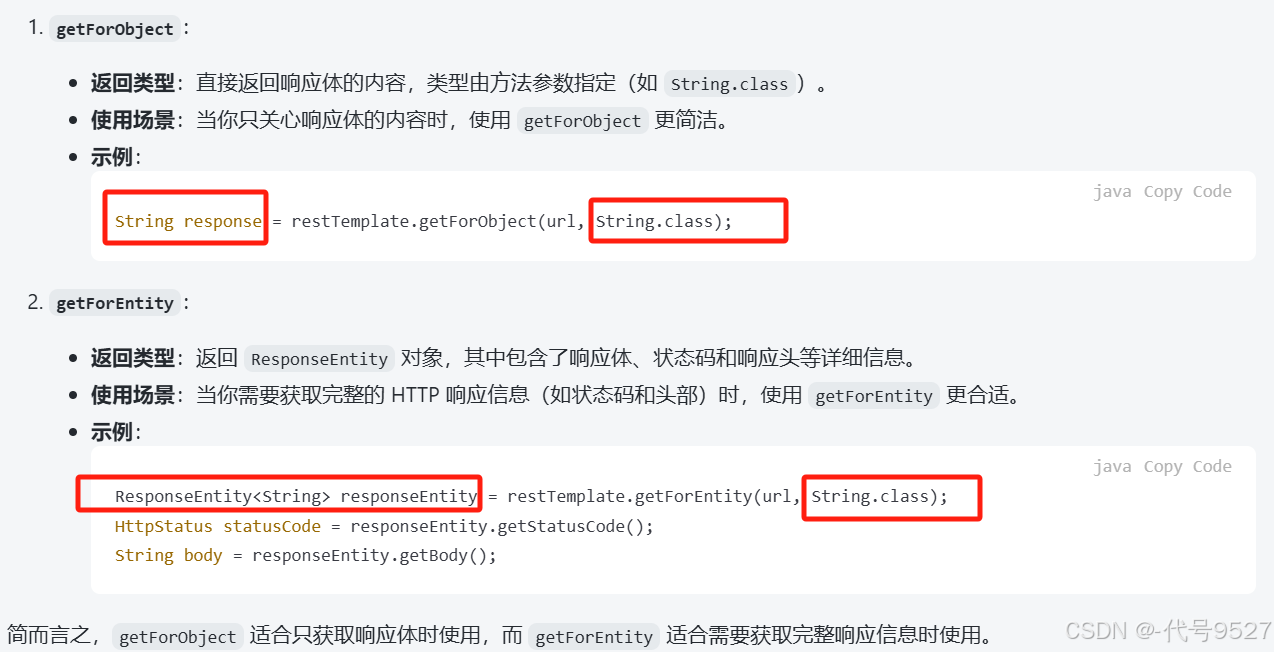Java中调用第三方接口
文章目录
- 0、测试接口
- 1、JDK的HttpURLConnection
- 2、Apache的HttpClient
- 3、SpringBoot的RestTemplate
- 3.1 GET
- 3.2 POST
- 4、SpringCloud的Feign
- 5、Hutool的HttpUtil
- 6、失败后重试
0、测试接口
写两个测试接口,一个GET,一个POST
@RestController
@RequestMapping("/svc1")
public class Controller {@GetMapping("/t1")public String doGet(@RequestParam(required = false) String name) {return "test" + name;}@PostMapping("/t2")public ResultVo doPost(@RequestBody RequestBodyDto dto, @RequestParam String key) {return new ResultVo(200, "操作成功", dto.getName() + dto.getChoose() + key);}}
1、JDK的HttpURLConnection
原生版,主要依靠JDK的 java.net包,GET请求:
import java.net.HttpURLConnection;
import java.io.BufferedReader;
import java.io.IOException;
import java.io.InputStreamReader;
import java.net.URL;@Slf4j
public class TestDemo {public static void main(String[] args) {BufferedReader reader = null;try {// 创建URL对象URL url = new URL("http://localhost:8080/svc1/t1");// 打开连接HttpURLConnection connection = (HttpURLConnection) url.openConnection();connection.setRequestMethod("GET");// 读取响应reader = new BufferedReader(new InputStreamReader(connection.getInputStream()));// 处理响应String inputLine;StringBuilder response = new StringBuilder();while ((inputLine = reader.readLine()) != null) {response.append(inputLine);}System.out.println(response);} catch (Exception e) {log.error("调用失败");e.printStackTrace();} finally {if (reader != null) {try {reader.close();} catch (IOException e) {e.printStackTrace();}}}}
}
URL类是JDK java.net包下的一个类,表示一个统一资源标识符(Uniform Resource Identifier)引用
POST请求:
import java.io.*;
import java.net.HttpURLConnection;
import java.net.URL;
import java.nio.charset.StandardCharsets;
import com.alibaba.fastjson.JSON;@Slf4j
public class TestDemo {public static void main(String[] args) {try {// 创建URL对象URL url = new URL("http://localhost:8080/svc1/t2?key=abc");// 打开连接HttpURLConnection connection = (HttpURLConnection) url.openConnection();connection.setRequestMethod("POST");// 设置请求头与数据格式connection.setRequestProperty("Content-Type", "application/json; utf-8");connection.setRequestProperty("Accept", "application/json");// 允许向服务器写入数据connection.setDoOutput(true);RequestBodyDto dto = new RequestBodyDto("Tom", "A");String json = JSON.toJSONString(dto);// 写入JSON到请求体try (OutputStream os = connection.getOutputStream()) {BufferedOutputStream bos = new BufferedOutputStream(os);bos.write(json.getBytes(StandardCharsets.UTF_8));bos.flush();}// 读取响应try (BufferedReader br = new BufferedReader(new InputStreamReader(connection.getInputStream(), "UTF-8"))) {StringBuilder response = new StringBuilder();String responseLine;while ((responseLine = br.readLine()) != null) {response.append(responseLine.trim());}System.out.println("Response: " + response.toString());}} catch (Exception e) {e.printStackTrace();}}
}

2、Apache的HttpClient
后续这些方式,本质上就是对java.net包的一个封装了。先引入Apache做http请求的依赖坐标:
<dependency><groupId>org.apache.httpcomponents</groupId><artifactId>httpclient</artifactId><version>4.5.13</version>
</dependency>
<dependency><groupId>org.apache.httpcomponents</groupId><artifactId>httpcore</artifactId><version>4.4.16</version>
</dependency>public class TestDemo {public static void main(String[] args) {try (CloseableHttpClient httpClient = HttpClients.createDefault()) {// 创建POST请求对象HttpPost httpPost = new HttpPost("http://localhost:8080/svc1/t2?key=abc");// 设置请求头httpPost.setHeader("Content-Type", "application/json; utf-8");httpPost.setHeader("Accept", "application/json");// 设置请求体RequestBodyDto dto = new RequestBodyDto("Tom", "A");String json = JSON.toJSONString(dto);StringEntity entity = new StringEntity(json);httpPost.setEntity(entity);// 执行请求并获取响应CloseableHttpResponse response = httpClient.execute(httpPost);HttpEntity responseEntity = response.getEntity();// 处理响应if (null != responseEntity) {String responseStr = EntityUtils.toString(responseEntity);System.out.println(responseStr);// 也可按需把json串反序列化成Java对象,略}} catch (IOException e) {e.printStackTrace();}}
}
3、SpringBoot的RestTemplate
使用SpringBoot封装的RestTemplate,依赖写web的:
<dependency><groupId>org.springframework.boot</groupId><artifactId>spring-boot-starter-web</artifactId>
</dependency>把RestTemplate的Bean放到IoC容器中:
@Configuration
public class RestTemplateConfig {@Beanpublic RestTemplate restTemplate() {return new RestTemplate();}
}
3.1 GET
发送Get请求,常用方法:
- getForObject
- getForEntity
/**
* url为请求的地址
* responseType为请求响应body的类型
* urlVariables为url中的参数绑定
*
*/
getForEntity(Stringurl,Class responseType,Object…urlVariables)/**
* URI对象来替代之前getForEntity的url和urlVariables参数来指定访问地址和参数绑定
* URI是JDK java.net包下的一个类
*
*/
getForEntity(URI url,Class responseType)
示例:
@SpringBootTest
class LearningApplicationTests {@Resourceprivate RestTemplate restTemplate;@Testvoid contextLoads() {String url = "http://localhost:8080/svc1/t1?name={name}";// 参数Map<String, String> paramMap = new HashMap<>();paramMap.put("name", "Tom");ResponseEntity<String> responseEntity = restTemplate.getForEntity(url, String.class, paramMap);// 状态码HttpStatus statusCode = responseEntity.getStatusCode();// 响应String body = responseEntity.getBody();System.out.println(statusCode + body);}}接口路径不用字符串,改为URI对象:
@Testvoid testTemplate() {String url = "http://localhost:8080/svc1/t1";String name = "Tom";// 使用 UriComponentsBuilder 构建 URLURI uri = UriComponentsBuilder.fromHttpUrl(url).queryParam("name", name).build().toUri();ResponseEntity<String> responseEntity = restTemplate.getForEntity(uri, String.class);// 状态码HttpStatus statusCode = responseEntity.getStatusCode();// 响应String body = responseEntity.getBody();System.out.println(statusCode + body);}
最后,getForObject:
getForObject(String url,Class responseType,Object...urlVariables)
getForObject(String url,Class responseType,Map urlVariables)
getForObject(URI url,Class responseType)
和getForEntity的区别是,getForObject只有一个响应的内容,响应码、响应头等没有

3.2 POST
常用方法:
- postForEntity
- postForObject
- postForLocation
以postForEntity为例,其参数可选:(重载)
postForEntity(String url,Object request,Class responseType,Object... uriVariables)
postForEntity(String url,Object request,Class responseType,Map uriVariables)
postForEntity(URI url,Object request,Class responseType)
示例:
@Test
void testTemplate2() {String url = "http://localhost:8080/svc1/t2?key=Tom";RestTemplate restTemplate = new RestTemplate();// 请求头HttpHeaders headers = new HttpHeaders();headers.add(HttpHeaders.AUTHORIZATION, "Bear xx");// headers.set("Content-Type", "application/x-www-form-urlencoded");headers.add(HttpHeaders.CONTENT_TYPE, "application/json");// 创建请求体对象并放入数据HttpEntity<RequestBodyDto> requestData = new HttpEntity<>(new RequestBodyDto("Tom", "A"), headers);// 和postForEntity一个意思ResponseEntity<String> responseEntity = restTemplate.exchange(url,HttpMethod.POST,requestData,String.class);// 获取响应状态码和响应体HttpStatus statusCode = responseEntity.getStatusCode();String responseBody = responseEntity.getBody();System.out.println(statusCode + " " + responseBody);
}
4、SpringCloud的Feign
上面的RestTemplate,在调三方接口时挺好用的,但微服务架构下,各个微服务之间调用时,url就不好写,由此,用Feign:一个声明式的http客户端
核心思路是声明出:
- 你调谁
- 用什么方式
- 请求参数是啥
- 返回类型是啥
引入依赖:
<dependency><groupId>org.springframework.cloud</groupId><artifactId>spring-cloud-starter-openfeign</artifactId>
</dependency>启动类上加上@EnableFeignClients
//在order的启动类中开启Feign
@EnableFeignClients
@MapperScan("com.llg.order.mapper")
@SpringBootApplication
public class OrderApplication{public static void main(String[] args){SpringApplication.run(OrderApplication.class,args);}
}- 以order服务调用user服务为例,编写调用方:
// 远程调用userservice服务
@FeignClient("userservice")
public interface UserClient {@GetMapping("/user/{id}")User findById(@PathVariable("id") Long id);// 后续接口自行添加
}!!findById这个方法名随便起
!!调用的接口路径、调用的服务名、请求参数、返回类型声明正确就行主要是基于SpringMVC的注解来声明远程调用的信息,比如:➢服务名称:userservice➢请求方式:GET➢请求路径:/user/{id}➢请求参数:Long id➢返回值类型:User
- 注入上面定义的FeignClient类,也就是UserClient,直接调用声明的那个方法
@Autowired
private UserClient userClient;public Order queryOrderById(Long orderId){//查询订单Order order = orderMapper.findById(orderId);//利用feign发起http请求,查用户User user = userClient.findById(order.getUserId());//封装,对象的某个属性也是个对象,即引用类型order.setUser(user);return order;
} - 被调用方有多个实例时,负载均衡也不用考虑,Feign用了Ribbon做负载均衡
- 关于Feign请求头的添加,可重写RequestInterceptor的apply方法:
@Configuration
public class FeignConfig implements RequestInterceptor {@Overridepublic void apply(RequestTemplate requestTemplate) {//添加tokenrequestTemplate.header("token", "eyJ0eXAiOiJKV1QiLCJhbGciOiJIUzUxMiJ9.eyJ4ZGFwYXBwaWQiOiIzNDgxMjU4ODk2OTI2OTY1NzYiLCJleHAiOjE2NjEyMjY5MDgsImlhdCI6MTY2MTIxOTcwOCwieGRhcHRlbmFudGlkIjoiMzAwOTgxNjA1MTE0MDUyNjA5IiwieGRhcHVzZXJpZCI6IjEwMDM0NzY2MzU4MzM1OTc5NTIwMCJ9.fZAO4kJSv2rSH0RBiL1zghdko8Npmu_9ufo6Wex_TI2q9gsiLp7XaW7U9Cu7uewEOaX4DTdpbFmMPvLUtcj_sQ");}
}
- 要做降级逻辑的话:如下,调用消息中心服务
// @FeignClient的fallbackFactory指定下降级逻辑的类
@Component
@FeignClient(contextId = "remoteMessageService", value = ServiceNameConstants.MESSAGE_SERVICE, fallbackFactory = RemoteMessageFallbackFactory.class)
public interface RemoteMessageService {/*** 发送定时消息任务:每分钟扫描发送消息** @return 结果*/@GetMapping("/inner/message/sendTimingMessage")public R<Void> sendTimingMessage();/*** 发送系统消息** @return 结果*/@PostMapping("/inner/message/sendSystemMessage")public R<Void> sendSystemMessage(@RequestBody MessageSendSystemDto messageSendSystemDto);
}
// 降级逻辑
@Component
public class RemoteMessageFallbackFactory implements FallbackFactory<RemoteMessageService>{private static final Logger log = LoggerFactory.getLogger(RemoteMessageFallbackFactory.class);@Overridepublic RemoteMessageService create(Throwable throwable) {throwable.printStackTrace();log.error("消息服务调用失败:{}", throwable.getMessage());return new RemoteMessageService() {@Overridepublic R<Void> sendTimingMessage() {return R.fail("调用发送定时消息接口失败:" + throwable.getMessage());}@Overridepublic R<Void> sendSystemMessage(MessageSendSystemDto messageSendSystemDto) {return R.fail("调用发送消息接口失败:" + throwable.getMessage());}};}
}
5、Hutool的HttpUtil
还是对 java.net的封装,引入依赖:
<dependency><groupId>cn.hutool</groupId><artifactId>hutool-all</artifactId><version>5.8.16</version> <!-- 请检查最新版本 -->
</dependency>处理GET和POST:
/*** @param url baseUrl* @param requestMethod 请求方式* @param headerMap 请求头参数key-value* @param paramMap 路径参数key-value,形如?name=Tom&country=Chain* @param bodyJsonStr post的body传参,json字符串* @return 响应体*/
public static String sendRequest(String url, Method requestMethod, Map<String, String> headerMap, Map<String, Object> paramMap, String bodyJsonStr) {// 路径参数不为空时,拼接URLif (paramMap != null) {UrlBuilder urlBuilder = UrlBuilder.of(url);paramMap.forEach((k, v) -> urlBuilder.addQuery(k, v));url = urlBuilder.toString();}//发送请求HttpResponse httpResponse = HttpUtil.createRequest(requestMethod, url).addHeaders(headerMap).body(bodyJsonStr).execute();return httpResponse.body();}
测试下:
@Test
void testHuTool() {String url = "http://localhost:8080/svc1/t1";Map<String, Object> paramMap = new HashMap<>();paramMap.put("name", "Tom");Map<String, String> headerMap = new HashMap<>();headerMap.put("Authorization", "Bear xx");String response = sendRequest(url, Method.GET, headerMap, paramMap, null);System.out.println(response);
}@Test
void testHuTool2() {String url = "http://localhost:8080/svc1/t2";Map<String, Object> paramMap = new HashMap<>();paramMap.put("key", "Tom");Map<String, String> headerMap = new HashMap<>();headerMap.put("Authorization", "Bear xx");RequestBodyDto dto = new RequestBodyDto("Tom", "A");String bodyJsonStr = JSON.toJSONString(dto);String response = sendRequest(url, Method.POST, headerMap, paramMap, bodyJsonStr);System.out.println(response);
}
6、失败后重试
考虑到远程调用可能失败,失败后重试三次,以上面的hutool为例来实现,其余的都一样,主要还是一个是否成功标记位 + 一个计数,successFlag不用voilate,并发安全也不用考虑,线程内部调用的,用到的数存栈里了都。
/*** @param url baseUrl* @param requestMethod 请求方式* @param headerMap 请求头参数key-value* @param paramMap 路径参数key-value,形如?name=Tom&country=Chain* @param bodyJsonStr post的body传参,json字符串* @return 响应体*/public static String sendRequest(String url, Method requestMethod, Map<String, String> headerMap, Map<String, Object> paramMap, String bodyJsonStr) {// 是否成功标记位boolean successFlag = false;// 重试次数累计int retryCount = 1;HttpResponse httpResponse = null;while (!successFlag && retryCount <= 3) {try {// 路径参数不为空时,拼接URLif (paramMap != null) {UrlBuilder urlBuilder = UrlBuilder.of(url);paramMap.forEach((k, v) -> urlBuilder.addQuery(k, v));url = urlBuilder.toString();}// 发送请求httpResponse = HttpUtil.createRequest(requestMethod, url).addHeaders(headerMap).body(bodyJsonStr).execute();if (httpResponse.getStatus() != 200) {retryCount++;} else {successFlag = true;}} catch (Exception e) {e.printStackTrace();retryCount++;}}return httpResponse == null ? null : httpResponse.body();}
